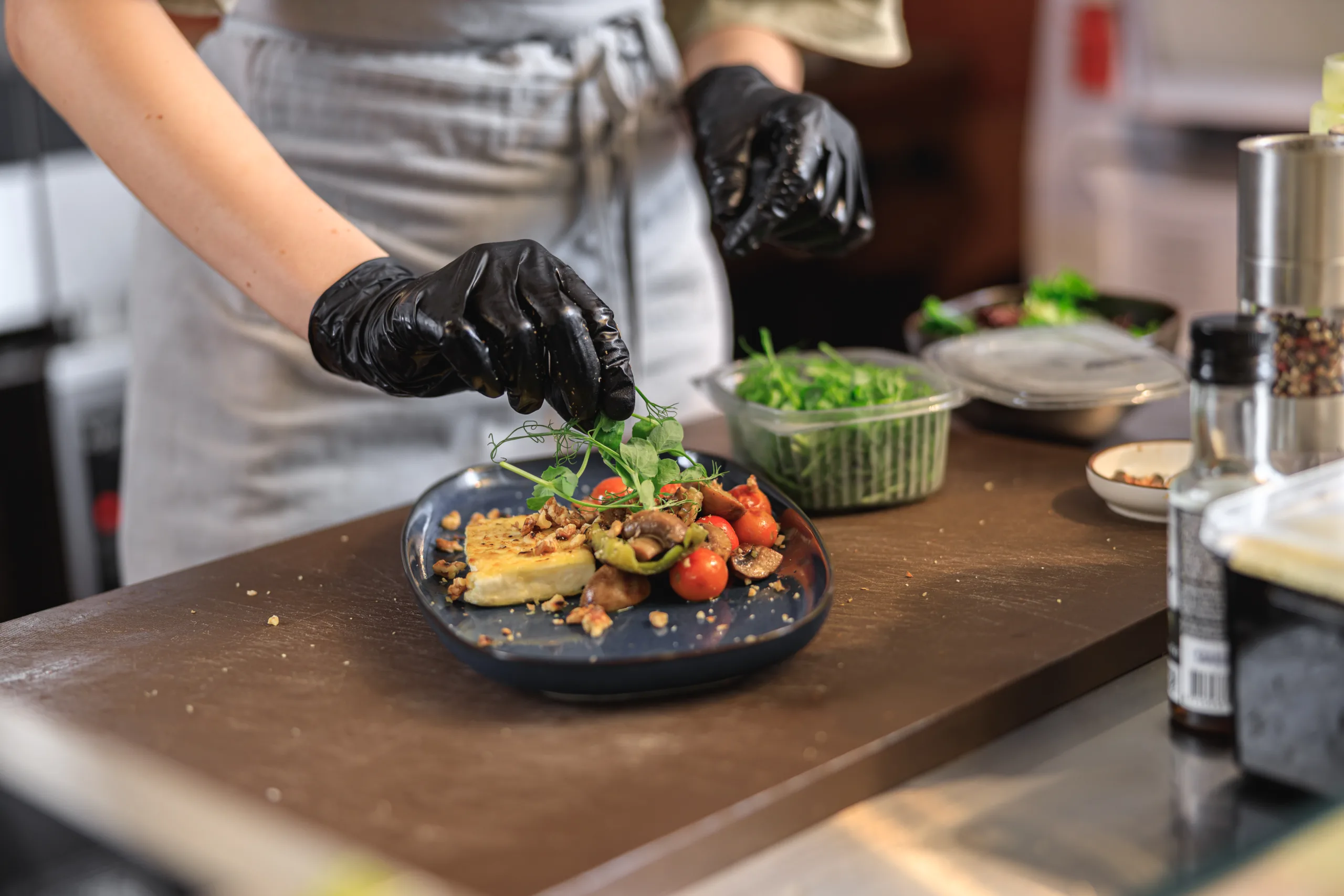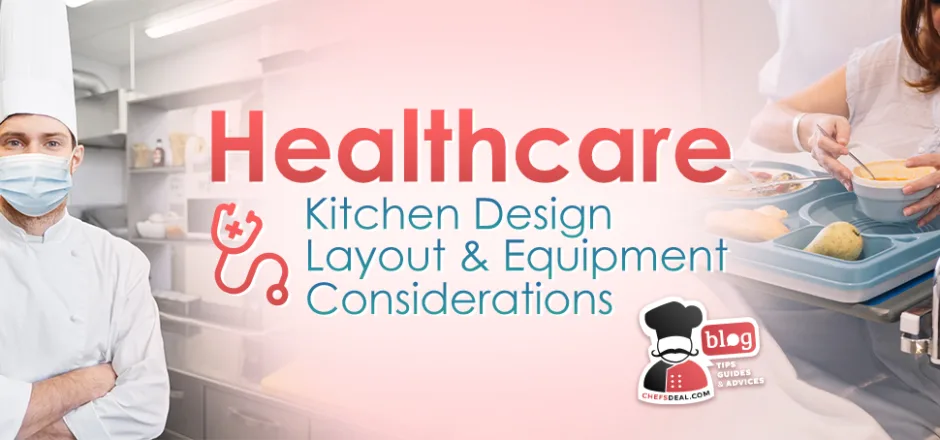The term “healthcare kitchen” encompasses many commercial kitchen facilities, from hospitals to nursing home kitchens. The common feature of these kitchens is their special attention to ensuring their customers’ physical and emotional health, who are mostly patients with specific dietary restrictions and requirements. Therefore, healthcare kitchen design, layout, and equipment considerations significantly differ from a regular commercial kitchen and require extra care.
Healthcare Kitchen Design Tips
In recent years, there has been a shift in healthcare kitchen designs, leaning towards vibrant colors and natural light as much as possible and striving to make cafeteria and restaurant areas more community focused. By considering some details, you can create a pleasant and friendly dining environment for patients and contribute to their well-being on a new level.
- Let Natural Light in: Fresh air and sunlight have been proven to improve people’s emotional and physical well-being. You can easily achieve this goal by incorporating big windows into your dining area.
- Opt for Vibrant Colors in Your Design: A hospital kitchen or cafeteria is not restricted to the usual whites and grays. Expand your palette and make the area colorful. Choosing fun and colorful furniture, equipment, and even wall colors will be a welcome change for patients and the staff.
- Setting up Purple Stations Within the Healthcare Kitchen is a Must: Purple stations are designed to cook allergen-free foods and contain their own equipment to prevent cross-contamination. Healthcare facilities serve many people who have different dietary restrictions. In order to not endanger people’s health, such measures are necessary.
- A Simple Assembly Line can Significantly Expedite the Cooking Process. Healthcare facilities house many people, and residents of the facility potentially need three meals a day. The staff needs to meet high demand regularly, and to prevent burn-out or shortage of food; you need a tried and true system to quickly prepare and deliver food.

Healthcare Kitchen Layout Considerations
The healthcare kitchen layout needs to be carefully designed, and there are things you should consider before choosing its placement within the building:
- It should be easily accessible for deliveries. Healthcare kitchens produce in great amounts and might require frequent deliveries of ingredients. You might consider the ground floor for easy delivery or ensure an elevator is close to the kitchen.
- It should be easy to find for patients and accessible from different wards. A cafeteria area often accompanies healthcare kitchens. Most facilities only have room and budget for one kitchen, so placing the kitchen closer to patient quarters would be best. This would help people find the cafeteria and help the staff easily and quickly deliver food to the rooms.
- Make sure there is room for walk-in refrigerators and freezers. Healthcare kitchens mass-produce and buy ingredients in bulk to reduce costs. The ingredients should be preserved well to prevent health hazards and waste. Walk-in refrigeration equipment is necessary to achieve this goal, and such units need space.
- Different stations for different types of food will be necessary for a healthcare kitchen. Even if the menu is kept small, healthcare kitchens need to have a range to meet the varied demands of the patients. Liquid meals for post-surgical patients cannot be prepared in the same space as daily baked goods for visitors in the cafeteria. You can organize your kitchen based on diet restrictions to avoid cross-contamination or mix-ups. Heart-healthy, diabetes safe, allergen-free, gluten-free, etc., are some categories you might need to prepare for.
Healthcare Kitchen Equipment
Healthcare kitchen equipment can be categorized into three units: general kitchen, service, and delivery. All three categories have nuances that should not be overlooked.
1. General Kitchen Equipment
In addition to the basic commercial kitchen equipment, you will need the following pieces for a good healthcare kitchen.
- Hygiene products are extremely important in healthcare kitchens. All staff should wear gloves and aprons. You can set up separate hand washing stations for the staff to regularly clean their hands with non-allergenic soaps to avoid infections and cross-contamination.
- Separate utensils should be used for different purposes. Utensils that handle allergic foods, such as peanuts, should not be confused with regular service utensils. Such mix-ups could lead to cross-contamination and endanger the health of the patients.
- Prep tables for different meal categories can help you organize the kitchen in a way that makes sense and is easy to navigate.
- Walk-in refrigerators and freezers are great for storing the ingredients you buy in bulk.
- Commercial dishwashers are necessary to maintain a sanitary environment. Washing the dishes at hand won’t be as fast and clean as you need it to be. Invest in a commercial dishwasher that can meet the capacity of your kitchen for the safest results.
2. Service Equipment and Supplies
You will need additional supplies if you are in charge of the cafeteria area in your healthcare facility.
- Insulated and cooled service counters ensure that meals are kept at a good temperature till they are served.
- Display cases are great for storing sandwiches and drinks. Cafeteria customers can browse the items through the glass display and easily reach in for the products they want.
- Make sure the serving staff is wearing gloves, bonnets, and aprons to minimize the spread of germs.

3. Delivery Equipment
Most healthcare facilities house long-term patients that cannot or prefer not to leave their rooms for meals. You will need several pieces of equipment to safely deliver food to such patients.
- Trolleys and wheeled storage racks are great for delivering meals from the kitchen to other rooms, carrying multiple meals at a time, and easily delivering them to their targets.
- Compartment trays are great options for reducing the dishwasher load in healthcare kitchens. They can serve several meals at once without producing plenty of dishes that must be handled.
- Plastic cups for certain things, such as desserts, could be favorable in reducing the dish load.
- Insulated or cooled holding cabinets can help your staff store the food until mealtime. Once the food is cooked and distributed into plates, it shouldn’t wait too long outside. Such holding cabinets can help you avoid food-borne diseases.
Conclusion
Healthcare kitchens are key to healthcare facilities such as hospitals and nursing houses. They take on the responsibility of taking care of patients and ensuring their physical and emotional well-being through food. The food you cook must be nutritious, sanitary, and safe for the diner. By paying special care to the design and layout of your kitchen in the first stages of set-up, you can ensure a smoother and better process in the future. While the equipment necessary for these environments is not drastically different, you can create a well-functioning and safe kitchen for your operations by paying attention to a few details.






